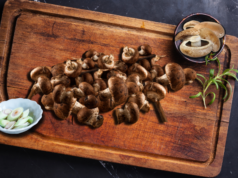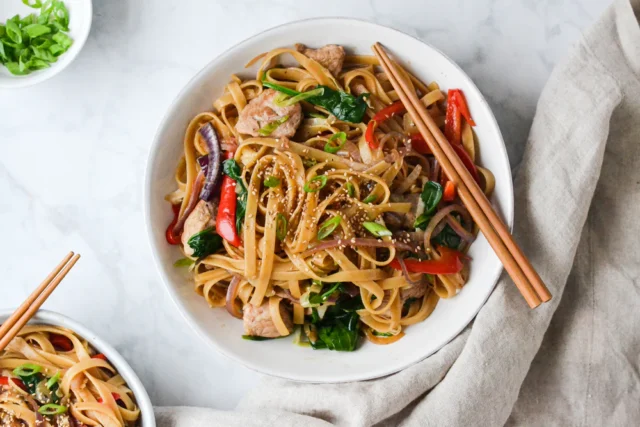
Noodle stir-fry is a delicious Peruvian dish that brings together the best of Asian and Latin American flavors. This fusion of cultures creates a unique and tantalizing experience for the palate. In the following lines, we will explore the origins, secrets, accompaniments and proper preservation methods of this incredible dish.
In addition, we will introduce you to another popular Peruvian rice dish, Arroz Chaufa, and explain what makes it special. Don’t miss the opportunity to prepare and enjoy these extraordinary recipes.
Ingredients
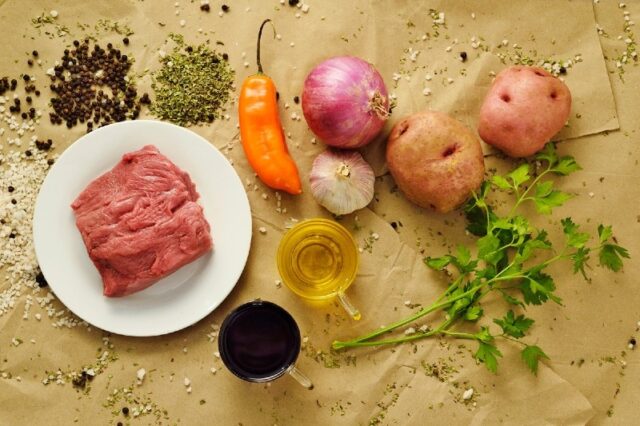
- 8 ounces of beef steak, thinly sliced
- 8 ounces of spaghetti or egg noodles
- 1 red onion, thinly sliced
- 1 red bell pepper, thinly sliced
- 1 green bell pepper, thinly sliced
- 2 tomatoes, cut into wedges
- 3 cloves of garlic, minced
- 2 tablespoons of soy sauce
- 2 tablespoons of oyster sauce
- 2 tablespoons of vegetable oil
- 1 tablespoon of Aji Amarillo paste (adjust according to your spice preference)
- Salt and pepper to taste
- Fresh cilantro leaves for garnish
Instructions
Step 1
Cook the noodles according to the package instructions. Once cooked, drain and set aside.
Step 2
In a bowl, marinate the beef slices with soy sauce, minced garlic, and a pinch of salt and pepper. Set aside for 10-15 minutes.
Step 3
Heat a large skillet or wok over high heat. Add vegetable oil and swirl it around to coat the pan evenly.
Step 4
Add the marinated beef to the hot skillet and stir-fry for 2-3 minutes until the beef is browned and cooked to your desired level of doneness. Remove the beef from the skillet and set aside.
Step 5
In the same skillet, add the sliced onions and bell peppers. Stir-fry for 2-3 minutes until they start to soften.
Step 6
Add the tomatoes to the skillet and continue stir-frying for another 1-2 minutes until they are slightly softened.
Step 7
Push the vegetables to the side of the skillet and add the cooked noodles to the center. Drizzle the oyster sauce and Aji Amarillo paste over the noodles.
Step 8
Toss everything together, incorporating the vegetables and noodles. Stir-fry for an additional 2-3 minutes to combine the flavors and ensure the noodles are heated through.
Step 9
Return the cooked beef to the skillet and toss everything together once again to distribute the beef evenly.
Step 10
Taste and adjust the seasoning with salt, pepper, or additional soy sauce if needed.
Step 11
Remove from heat and garnish with fresh cilantro leaves.
Step 12
Serve the Tallarin Saltado hot
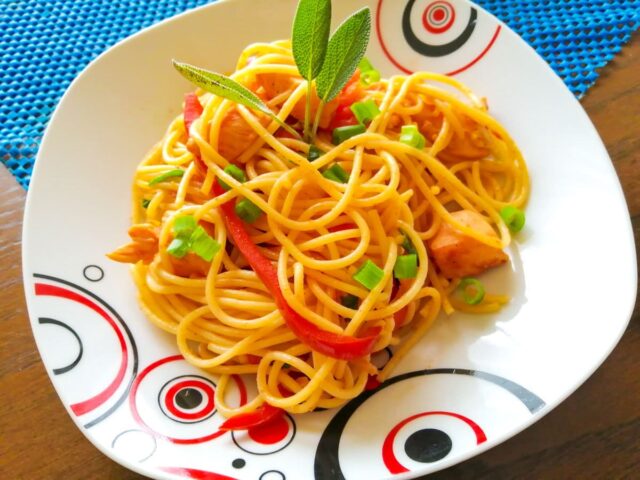
Origins and Cultural Fusion
Tallarin Saltado originated in Peru, where Chinese immigrants brought their culinary traditions and blended them with Peruvian ingredients and cooking techniques.
The result is a harmonious marriage of flavors that combines the freshness of Latin American produce with the boldness of Asian stir-frying. The dish quickly became a staple in Peruvian cuisine and is loved by locals and visitors alike.
Secrets to the Perfect Tallarin Saltado
To create an outstanding Tallarin Saltado, follow these secrets from Peruvian kitchens:
Quality Ingredients: Use fresh vegetables like bell peppers, onions, and tomatoes to enhance the flavors. Opt for tender strips of beef or succulent chicken to complement the dish.
Marination: Before stir-frying the meat, marinate it in a mixture of soy sauce, garlic, and spices. This step infuses the meat with rich flavors and tenderizes it.
High Heat Stir-Fry: To achieve the signature crispiness and vibrant colors, stir-fry the ingredients over high heat for a short period. This method ensures that the vegetables retain their crunchiness and the meat remains juicy.
Aji Amarillo: Add a touch of Peruvian flair by incorporating Aji Amarillo, a yellow chili pepper paste, to provide a pleasant, spicy kick to the dish. Adjust the amount according to your preferred level of heat.
The Perfect Pairing Arroz Chaufa
Arroz Chaufa is another popular Peruvian dish that beautifully complements Tallarin Saltado. This fried rice dish, also influenced by Chinese cuisine, features a delicious blend of rice, eggs, vegetables, and meat. The flavors are elevated with soy sauce and a hint of ginger. To learn more about Arroz Chaufa and how to prepare it, check out this amazing recipe at insert link: what is chaufa
The Versatility of Tallarin Saltado
One of the remarkable aspects of Tallarin Saltado is its versatility. While traditionally made with beef or chicken, you can easily customize the dish to suit your preferences or dietary restrictions. Here are a few variations to consider:
Seafood Delight
Swap the meat with shrimp, squid, or a medley of seafood to create a tantalizing seafood version of Tallarin Saltado. The delicate flavors of the seafood will complement the vibrant vegetables and savory sauce perfectly.
Vegetarian Twist
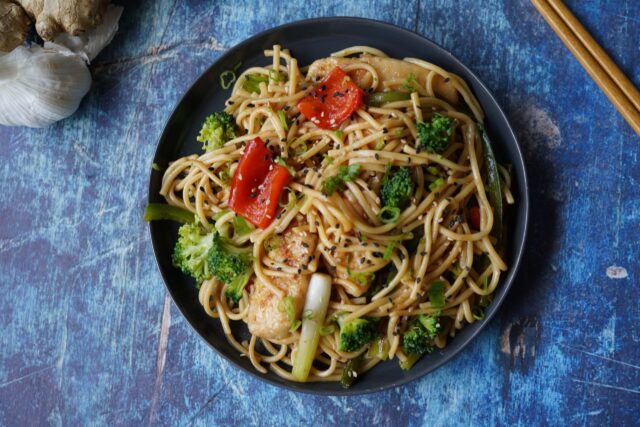
For a vegetarian option, omit the meat altogether and load up on a colorful assortment of vegetables. Mushrooms, zucchini, and broccoli work wonderfully in this dish, adding their unique flavors and textures.
Accompaniments and Serving Suggestions
- Salsa Criolla: Top your Tallarin Saltado with this refreshing condiment made with thinly sliced red onions, lime juice, and a sprinkle of cilantro. It adds a tangy and aromatic touch to the dish.
- Steamed Rice: Serve your Tallarin Saltado alongside steamed white rice or Arroz Chaufa for a satisfying and well-balanced meal.
- Inca Kola: Quench your thirst with a glass of Peru’s iconic soft drink, Inca Kola. Its sweet and fruity flavor perfectly complements the savory notes of the dish.
Proper Storage and Reheating Tips
Refrigeration: Store the cooked Tallarin Saltado in an airtight container in the refrigerator. It can be kept for up to 3 days.
Reheating: To reheat the dish, stir-fry it in a hot skillet or wok for a few minutes until heated through. This method helps maintain the dish’s texture and flavors.
Tallarin Saltado and Arroz Chaufa offer a delightful journey into the fusion of Peruvian and Asian cuisines. With their vibrant colors, robust flavors, and unique combinations of ingredients, these dishes are sure to become favorites in your culinary repertoire. So, gather the necessary ingredients, follow the steps, and embark on a mouthwatering adventure that will leave you craving for more!

